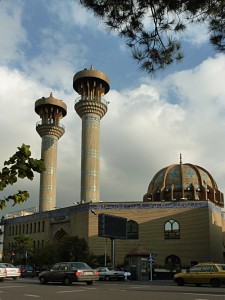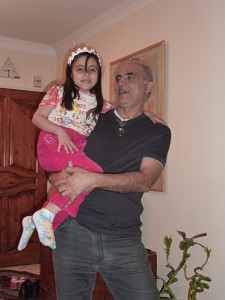After my long train ride from Turkey to Tehran, I had three days to discover the capital of Iran. The city has a very distinct character, which reflects the character of the people in Iran.
After a good sleep and an extensive breakfast, I started my typical walk around the city. I had bought a city map, to find my way back after a first stop at the exchange booths of the city.
The very good and centrally located Hotel Firouzeh is one of the cities meeting points of travelers in Teheran. The exchange with other travelers provided me with a good head start of knowledge about the city, which I then could test and observe myself by walking through this immense city. In the Southern and older part of the city, the shops along the streets are sorted by wares they sell. It thus happens that on Amir Kabir street, near which my hotel is located, one can buy spare parts for motorcycles and cars. Around the corner, the focus lies on fishing gear, followed by equipment for the bath and around yet another corner the exchange booths. Having all the exchange booths of the city in one corner has the nice effect, that one can compare rates really easily and thus get very good rates. Exchange rates can also be negotiated when exchange a larger amount of money (100 Euros being enough).
To arrive at my destination though, I had to master quite a few challenges, since there were many roads to be crossed. Back in Turkey, the rules on the road were straightforward: the one with the most horse-power wins. In Teheran the laws of the streets are much more subtle: as a pedestrian, the vehicles to worry most about are the thousands of motorcycles. They only break in the most dangerous situations, and sometimes not even then. Buses also have the right of way over pedestrians, but not so over cars, which can be stopped by pedestrians in many cases. The most important lesson about crossing streets in Teheran: once you have started to cross the street, don’t stop or slow down, but continue at a solid pace to get out of everybodys way. Unless a bus or a motorcycle is approaching. Important to know: motorcycles do not respect red lights, may run down a street the wrong way and sometimes even appear on the sidewalk. There are also bus lanes going the wrong way in one way streets.
My stroll on Wednesday served to figure out traffic and with the help of my city map to visit a few sights and parks.
On Thursday, I performed a layed out sight-seeing tour. One of the goals was to try out the different means of transport in Teheran. I started by walking to the Golestan Palace, known to the local people as Arg, the seat of the provinicial government. The palace was built and used by the shas of the Qajar dynasty. The palace’s traditional architecutre is quite a contrast comparing to the modern city of more than 13 million people surrounding it. I was particularly impressed by the decoration with small mirrors on the inside and on the outside of the palace. The rooms change their looks with each step one makes within, because different mirrors flash in the light.
The Golestan Palace was followed by a visit to the bazaar in Teheran. Unlike other cities, where the bazaar is mainly one building, the bazaar in Teheran is actually a full part of the city. The owners of the different shops in the bazaar are thus also quite powerful people in the city. The main difference to other parts of the city is the fact, that there are almost only pedestrians inside, the occasional motorcycle and the carts being pushed by people being the exceptions. The bazaar once again serves as an all-in-one stop for any need one might have. From artificial flowers and wigs to home appliances and spare parts of all kinds, everything can be found. The bazaar in the Southern part of Teheran is the place to go for the poorer half of the city living in the South, whereas the Northern part of the city features shops and malls the way I know them.
Following the visit of the bazaar, I had planned to take a look at Shahr park. Although the enter of Teheran can very well be discovered on foot, eventually you might still consider taking some means of transport to relax your feet. In front of the bazaar, a few motorcycle drivers asked me to take a picture of one of their colleagues. I took the picture and asked Muhammad, the victim of the stunt, to give me a ride to the park. Such a motorbike ride in the streets of Teheran is real fun. Try it, should you ever end up in that city.
To reach the Azadi tower from Shahr park, I decided to take the metro to the stop called Azadi. During this trip I learned two things: the separation of genders, as suggested by the subway company, does not work as intended. I was wondering what the men were looking for in the women only section of the train. Once I arrived at the other cars, I finally realized the reason for this fact. The trains were packed, such that the men were flowing over from the mixed in the women’s section. The second thing I learned was that there are streets and squares with the same names and thus a metro station carrying one name, might not be what you think its. The mistake was corrected easily with the second motorcycle ride of the day.
The Azadi tower was built in 1971 to comemorate the 2500 years of the Persian Empire. Today, the fundament features an interesting exhibition of raw and processed minerals. I had higher goals, since I wanted to enjoy the view from the tower.
The first tower was followed by a second one: I took a taxi to the Milad tower, the fifth or sixth tallest TV tower in the world (depending on whether you already count the soon to be opened Tokyo Sky Tree or not). The observation desk is reached using Schindler’s Lift from Switzerland, as one is explained during the ride up at a typical 7m/s and maximum 10m/s.
The view from the tower unto the city and the mountains in the North are fantastic. The city is covered in smog, such that the edges of the city in the East, South and West are not visible. In the North however, one can clearly see the more than 4000m tall mountains, which also sport a ski resort in the winter. To bad I don’t have the time for a day of skiing. On the other hand the thought of wearing t-shirts again in the South of the country isn’t that bad either.
From the Milad tower, I took the next bus bringing me to any metro station, which I find with a little help from a local. The metro leads me back to the Emam Khomeini square from where I walk back to the hotel.
On Friday, I followed my first invitation from an Iranian person. Lenka’s colleague Aida is Iranian and her mother still lives in Tehran. We agreed to meet on Friday at noon for lunch together. She showed up with her neighbor Ali, who drove us to a restaurant to eat the Iranian speciality Dizi. Meat from the lamb is cooked for 5 to 6 hours with pieces of fat in a soup. The soup is eaten as a starter with the typical Iranian bread, with the bread torn into pieces and put into the soup. The meat and fat are stamped with a mortar which leads to a mash which is enhanced with beans. The mash is eaten with bread and different kinds of sauces. As a side dish, there are onions, a sort of Rucola salad and lemons to spice the different parts of the meal. The meal was delicious but unfortunately a little bit rushed, since the restaurant is very popular with the locals.
Following the meal we drove to the building were the two live, where I had the first part of a very interesting exchange with Ali. Aida’s mother then served us some tea, before it was time to say goodbye to her, because she had some obligations to tend to.
Ali gave me an introduction to Iranian art, first stopping at the 6th national sculpture biennale before heading to a small gallery, where the showed calligraphic paintings. For dinner we headed back to Ali’s apartment, where we met an old friend of his with the friend’s wife and their daughter. Futher interesting discussions followed, first among the four of us, later just between Ali and me. Ali had the chance to visit quite a few countries and it was interesting showing each other pictures of the places we had been to.
Another interesting topic was his opinion and his knowledge about Iran and the political situation in the region. Iran is suffering from similar problems as the Western countries. There are many sheep following a shepherd without understanding why this might be a good or a bad idea. If change came to the country, it would surprise many in the West, since the Iranians who are yearning for change, are not looking exactly at what the West is doing. The sub-prime crisis and the current debt crisis in Europe make them think, that the Western system is not the solution, but just another problem.
Late at night, Ali provided me with a ride back to my hotel, where I read and heard about the many birthday wishes which were transmitted by E-Mail, Skype and Facebook, before I tiredly fell into my bed.
On Saturday it was time to pack my backpack and to organize my first ride on an Iranian bus. With a traveler from Singapore, I headed for the bus terminal, in front of which we were asked by many people, where we were headed. The all pointed us to the correct bus, which was leaving, once we were on board. I guess they were just waiting for the two of us. Of we went to my next destination, to Kashan.










